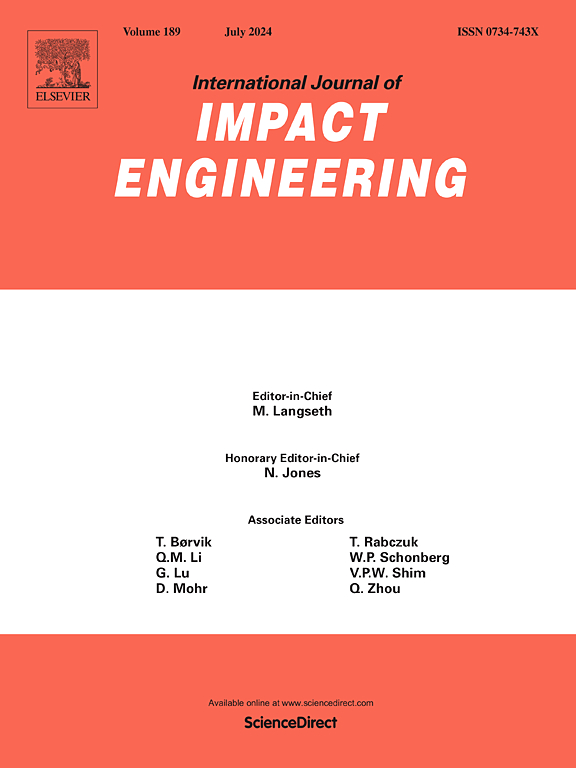交叉层压木材(CLT)与纤维复合材料在弹道冲击下的界面相互作用
IF 5.1
2区 工程技术
Q1 ENGINEERING, MECHANICAL
International Journal of Impact Engineering
Pub Date : 2025-05-18
DOI:10.1016/j.ijimpeng.2025.105394
引用次数: 0
摘要
增强交叉层压木材(ECLT)通过在木层之间引入历史上相关的抗弹道材料(例如钢,e -玻璃等)来利用CLT的分层特性,以增加整体的抗弹道能力。自2017年以来,研究人员利用不同的木材品种、增强材料和制造技术探索了概念弹道实验的证明。然而,为了整合设计标准和开发分析模型,我们必须可预测地了解木材和增强材料之间界面的相互作用。本文介绍了用热改性海岸铁杉和三种不同的纤维基增强材料进行的80次弹道试验的结果。试验是在美国陆军工程研究发展中心破碎模拟设施进行的,试验采用了一种新的方案,旨在实验和物理地检查多材料界面的界面相互作用,同时考虑到应变率依赖性和木材固有的材料可变性。实验结果表明,除了热改性沿海铁杉CLT与三种不同纤维增强材料之间添加粘附界面外,其弹道阻力平均增加了34 ~ 59焦耳(5.1% ~ 6.8%)。此外,尸检计算机断层成像显示,在靠近增强材料层的CLT层中,裂缝带投影面积增加,复制了复合陶瓷装甲的典型界面破坏剖面。本文章由计算机程序翻译,如有差异,请以英文原文为准。
Interface interaction between cross laminated timber (CLT) and fiber composites under ballistic impact
Enhanced Cross Laminated Timber (ECLT) leverages the layered nature of CLT by introducing historically relevant ballistic resistant materials (e.g. steel, E-glass, etc.) between wood layers to increase overall ballistic resistance. Researchers have explored proof of concept ballistic experiments utilizing different wood species, enhancing materials, and manufacturing techniques since 2017. However, for integration in design standards and development of analytical models, we must predictably understand interactions at the interface between wood and enhancing materials. This article presents the results of 80 ballistic experiments using thermally modified coastal western hemlock and three different fiber-based enhancing materials. Tests were performed at the United States Army Engineer Research Development Center Fragmentation Simulation Facility under a novel protocol aimed to experimentally and physically examine interface interactions at the multi-material interface, considering strain rate dependency and inherent material variability in the wood. The experimental results showed the ballistic resistance increased on average between 34 and 59 Joules (5.1 % and 6.8 % gains), excepting one outlier with the addition of an adhered interface between thermally modified coastal western hemlock CLT and three different fiber enhancing materials. Additionally, post mortem computed tomography imaging showed an increased fracture zone projected area in the CLT ply adjacent to the enhancing material layer that replicated typical interface failure profiles in composite-ceramic armors.
求助全文
通过发布文献求助,成功后即可免费获取论文全文。
去求助
来源期刊

International Journal of Impact Engineering
工程技术-工程:机械
CiteScore
8.70
自引率
13.70%
发文量
241
审稿时长
52 days
期刊介绍:
The International Journal of Impact Engineering, established in 1983 publishes original research findings related to the response of structures, components and materials subjected to impact, blast and high-rate loading. Areas relevant to the journal encompass the following general topics and those associated with them:
-Behaviour and failure of structures and materials under impact and blast loading
-Systems for protection and absorption of impact and blast loading
-Terminal ballistics
-Dynamic behaviour and failure of materials including plasticity and fracture
-Stress waves
-Structural crashworthiness
-High-rate mechanical and forming processes
-Impact, blast and high-rate loading/measurement techniques and their applications
 求助内容:
求助内容: 应助结果提醒方式:
应助结果提醒方式:


